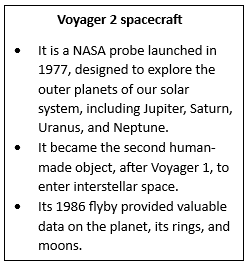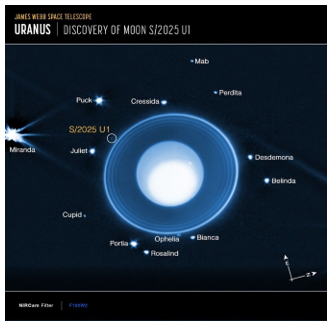Syllabus:
GS-3: Awareness in the fields of IT, Space, Computers, robotics, nano-technology, bio-technology and issues relating to intellectual property rights.
Context:
Recently, NASA announced the discovery of a new, 29th moon orbiting Uranus by the James Webb Space Telescope.
More on the News
- According to NASA, a team led by the Southwest Research Institute (SwRI) identified the moon on the 2nd of February 2025, expanding the planet’s known satellite family to 29.
- The new moon has been provisionally called ‘S/2025 U1,’ and is yet to be formally named by the International Astronomical Union (IAU), the leading authority in assigning official names and designations to astronomical objects.
About New Moon- S/2025 U1

- The diameter of the moon is estimated to be only some 10 kilometres, relatively smaller, which made it invisible to NASA’s Voyager 2 probe during its 1986 flyby of the planet.
- It is located about 35,000 miles or 56,000 kilometers from Uranus’ center, orbiting the planet’s equatorial plane between the orbits of Ophelia and Bianca (other moons of Uranus).
- The new moon is the 14th member of the intricate system of small moons orbiting inward of the largest moons Miranda, Ariel, Umbriel, Titania, and Oberon.
- Significance: This discovery enhances understanding of Uranus’s moon and planetary system, with ongoing observations to determine the new moon’s orbit and characteristics.
About Uranus
- Uranus is the seventh planet from the sun and a cold, blue-green ice giant, named after the Greek god of the sky.
- It’s primarily composed of water, ammonia, and methane, with a swirling atmosphere of hydrogen and helium that gives it its distinct colour.
- A key characteristic is its extreme axial tilt, causing it to rotate on its side, leading to unique seasons with decades of continuous daylight or darkness at its poles.
- Uranus’ 28 moons include five major moons, Titania, Oberon, Umbriel, Ariel and Miranda, discovered between 1787 and 1948. These are known as “the literary moons.”
- The first two moons, Titania and Oberon, were discovered in 1787, while the 28th moon, S/2023 U1, was identified in November 2023 at the Las Campanas Observatory, Chile.
- Uranus’ moons are traditionally named after characters from the works of Shakespeare and Alexander Pope.
James Webb Space Telescope (JWST)

- It is the largest and most powerful space telescope ever built, designed to observe the universe in infrared light to study the first stars and galaxies, the formation of planetary systems, and to analyse exoplanet atmospheres.
- A collaborative effort by NASA, the European Space Agency (ESA), and the Canadian Space Agency (CSA), launched on December 25, 2021.
- It orbits the Sun 1.5 million kilometers away from the Earth at what is called the second Lagrange point or L2.
- Its longer wavelengths allow it to probe the early universe and observe star and planetary system formation within dust clouds.

